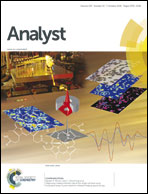Electrochemical sensor with substitutional stripping voltammetry for highly sensitive endotoxin assay†
Abstract
We have developed a novel method for detection of endotoxin with extra-high sensitivity by using substitutional stripping voltammetry (SSV). In this method, a p-aminophenol (pAP) conjugated peptide (Boc-Leu-Gly-Arg-pAP; LGR-pAP) was used as a substrate for a protease, which is activated at the last step of the endotoxin-induced Limulus amebocyte lysate (LAL) cascade reaction. Extra-highly sensitive detection of pAP liberated by the endotoxin-induced LAL reaction was successfully realized with SSV, based on the accumulation of an amperometric signal owing to exchange of the oxidation current of pAP generated at an electrode in a reaction cell with silver deposition on another electrode in a deposition cell. This reaction is driven by the difference in the redox potential between pAP/quinoneimine and silver/silver ion. The amount of the deposited silver is quantified by anodic stripping voltammetry (ASV). This SSV-based endotoxin assay was performed with a chip device comprising two cells, each of which was connected via a liquid junction made of Vycor® glass. The reaction cell and the deposition cell contained a standard endotoxin sample with LAL regents containing LGR-pAP and AgNO3 solution, respectively. After the cells were electrically connected for 60 min, ASV was conducted in the deposition cell to quantify the total electrical charge derived by the oxidation of free pAP in the reaction cell. The ASV signal increased with the increase of the endotoxin concentration in the sample solution in the range of 0.5–1000 EU L−1.


 Please wait while we load your content...
Please wait while we load your content...